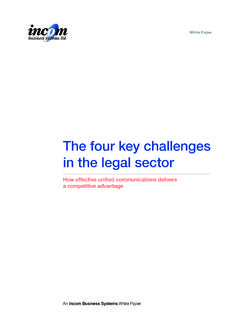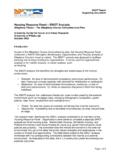Transcription of The four key challenges in the housing sector
1 White PaperThe four key challenges in the housing sectorHow effective unified communications delivers a competitive advantage An Incom Business Systems White Paper2 INTRODUCTIONThe social housing sector is undergoing significant changes as it faces a number of new challenges . External factors, including regulatory and welfare reform, plus demand for new housing outstripping supply, are having a profound effect on traditional operating current shortage of housing is forcing providers to consider their roles and responsibilities carefully. While the provision of affordable housing remains the core offering, many providers are undergoing radical organisational transformation, resulting from increased portfolio diversity which may include market rented properties, part buy, sales and new reform and universal credit are exerting increasing influence over the way that housing providers perform.
2 In addition, the Public Services Social Values Act 2012 is exerting pressure on the sector to play an active role in the creation of sustainable and more socially inclusive are becoming more discerning customers, demanding increasingly sophisticated and personalised communication channels to engage with their provider, but also to track and manage repair histories, rental balances and interactions with their landlord. Tenant engagement and empowerment remains a high priority, as the sector strives to embrace digital further factor is the changing nature of the modern workforce. The current employment market is populated with digital-savvy, socially-conscious generation Y resources, and housing providers need to work hard to attract and retain them.
3 This evolving workforce has clear expectations of a work-life balance and the sector must adjust to meet the emergence of flexible working arrangements and an increasingly mobile workforce. As a result, the principal challenge for today s housing sector is to utilise technology that delivers business transformation while meeting stringent regulatory requirements, including the Homes & Communities Agency s (HCA) Value for Money (VfM) effective ways of using advanced communication technologies will be key to the success of housing providers, providing the foundation for responsive and seamless communications within the organisation, as well as externally with tenants, service providers and other parties.
4 This white paper provides an overview of the key challenges currently faced by the housing sector and the benefits that can be derived from a successful unified communications implementation. While the provision of affordable housing remains the core offering, many providers are undergoing radical organisational transformation, resulting from increased portfolio diversity which may include market rented properties, part buy, sales and new build. 3 THE FOUR KEY challenges FACING THE housing sector Much has been written about the 21st century agile housing provider and it is clear that those that adapt and change their working practices and processes to meet evolving market forces will be the best equipped to thrive in a challenging environment.
5 Business agility in any environment requires a deep knowledge, clear understanding and foresight of the specific issues, so that effective strategies can be deployed to alleviate their impact. We have used research from a number of independent sources as well as feedback from our housing clients, to identify the four key challenges faced by organisations within the UK housing housing SUPPLYS ince the economic crisis, rising house prices and demand outstripping supply have exerted huge pressure on the provision of affordable housing . Some sources estimate that 500,000 new houses need to be built every year for the next 25 years, and if demand continues, this figure could increase to as many as two million new homes required per year by development has traditionally been grant-led and while some of the shortfall will be funded via central government, there is still a considerable gap in finance availability with little new build social housing coming out of the ground.
6 The welfare reform agenda has also presented further challenges to social housing providers, with figures identifying that pilot schemes testing the new direct payment of housing benefits show an 8 per cent drop in rent collections on Other figures show that in areas where universal credit has been paid direct, there is up to 90 per cent arrears on this this potent mix of diminishing rental income and reduced central government grants is forcing housing providers to review their traditional service offering and think commercially, while continuing to act socially. The potent mix of diminishing rental income and reduced central government grants is forcing housing providers to review their traditional service offering and think commercially, while continuing to act socially.
7 4 THE FOUR KEY challenges FACING THE housing sector COnTInUed2. TECHNOLOGY INFRASTRUCTUREFor many years, housing providers have operated using familiar and unchanging business processes. Software and business process applications have either been developed in-house by teams of IT experts, third-party applications have been bought and adapted to the specific needs of the provider, or bespoke packages have been bought in and evolved with the growing organisation. With a backdrop of market consolidation in the housing sector , many providers have joined forces, with numerous disparate systems and applications being used in silos within the organisation.
8 The net result is that many housing providers face considerable legacy system issues with a proliferation of mutually exclusive systems in play, used by different teams and departments across the organisation, meaning there is little or no collaboration or integration. This brings significant challenges for staff, making it harder for them to collaborate with co-workers and restricting their ability to efficiently handle tenant enquiries. Greater investment in IT infrastructure and communication tools is required to ensure seamless working across asset management, CRM, repairs and workforce management systems.
9 This investment is vital, if housing providers are to achieve their core business goals of better tenant communication, improved levels of tenant satisfaction and cost efficiencies. housing providers will need to provide evidence of achieving value for money from their IT strategies as defined by the HCA s VfM standard, with evidence showing that the HCA is taking a more robust approach to is something that housing providers seem to have accepted as they are currently spending around 40 per cent of their IT budgets on business as usual and around 42 per cent on capital or operational costs of new IT CHANGING WORKING PRACTICES AND MOBILITYW ithout a doubt, one of the greatest revolutions in today s workplace is the increasing trend of flexible working practices.
10 Irrespective of the sector , the way in which staff work and their location has changed immeasurably in the past ten years. Recent government data5 suggests that there were over million home workers in the UK in 2014, equating to of the total working population, with of the million occupied in higher skilled roles. The days when all employees worked under a single roof are numbered with multiple sites, home and remote working all becoming more prevalent, as organisations strive to recruit and retain the best skilled workers. Thanks to the consumerisation of IT and the always on nature of modern life, a vast number of people have developed a new set of skills relating to mobile these new developments, employees expect the same ease of access to systems and applications and a collaborative working environment, in just the same manner as they d get within a traditional office-based role.






